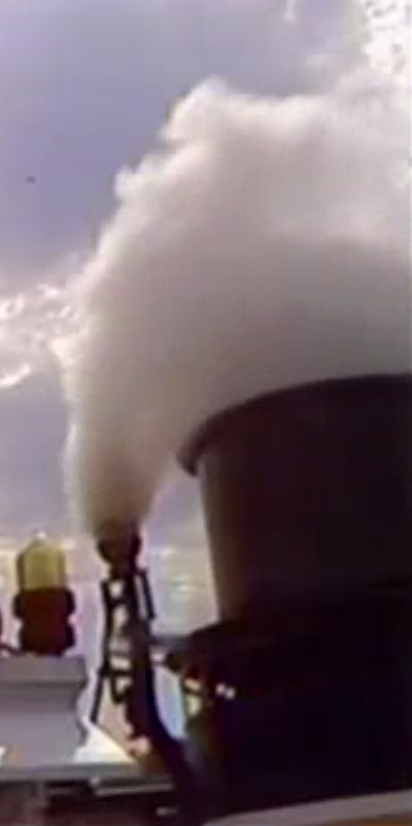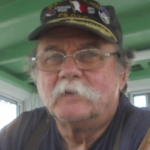The riverboat captain is a storyteller, and Captain Don Sanders will be sharing the stories of his long association with the river — from discovery to a way of love and life.
By Capt. Don Sanders
Special to NKyTribune
“Let’s crank up this here old boat and get on outta here,” the Captain mentioned to the Mate in an unusually gentle tone as they stood side-by-side above the forepeak of the aging steamboat. That said, the Captain, a human colossus standing 6-feet-four in his stocking feet, and weighing nearly 18 stone, reached for a brass handle hanging alongside the forward mast and pulled hard. Above them, forward on the Hurricane Roof, a matronly bystander screamed in terror as the silver-bronze bell she’d been standing alongside exploded into a series of three sets of three eruptions.

“RINGING NINE,” the Master gleefully shouted as he heaved on the steel cable attached to the cast iron clapper within the mouth of the magnificent bell.
Immediately, the three-chimed, gold-plated Lunkenheimer whistle mounted on the bonnet of the smokestack joined the cacophony of bells, shouts, and scurrying feet comprising the panoramic bustle of a steamboat aroused from slumber while dozing against a Mississippi River shoreline.
“BREAK UP,” the Mate screeched to the clutch of deckhands appearing suddenly like apparitions from nowhere. Squeaking pulleys, the metallic sigh of the landing stage as a heel-tie line slackened and the stage flexed and relaxed from the strain it had been in reaching the shore added to the symphony. Onshore, shouts from late-arriving passengers and crewmen racing toward the long gangway bridging the gap to the steamer now fully awake and snorting bull-like and impatient to break the bonds fastened it to the land.
“WAIT… WAIT… DON’T LEAVE WITHOUT US… the chorus bustling down the sandy bank pleaded.
“SLOW DOWN. STOP RUNNING. THERE’S PLENTY OF TIME,” the Mate bellowed. Nearby, the capstan man muttered within earshot of the deckhand holding onto the Belly Block pull, “Or you’re liable to break your damned necks.” Amused, both men laughed at the capstan man’s comment.

Two hundred feet aft of the bow, on the Main Deck, the nearly ear-splitting cry of the Engine Order Telegraph (EOT) announced the departure of the steamboat within 15 minutes. The Engineer-on-watch and his apprentice “Striker” scrutinized last-minute details with the engines, feedwater pumps, boilers, firebox, steam siphons, cylinder cocks, and the dozens of other checks. Once satisfied that all was ready, the Engineer answered the EOT signaling the Pilot that the “shoving end” of the vessel was alert, prepared, and standing by.
On the aft end of the Texas Deck, the “Professor” seated at the calliope keyboard ran their hands across the keys of the electronics keyboard to jettison any condensation lingering within the brass whistles of the “god-awful musical instrument from hell” and broke into a tune best known to the ears of long-dead citizens of nearly two centuries earlier. Practically everyone within earshot of the sound, up to five miles away depending on the direction and velocity of the wind, loved what emanated from within the depths of the brass whistles. The only exceptions were, generally speaking, the pilots of the steamboat who griped about nearly everything and everybody. Whether it was fear or respect for the big man, the pilot’s gripes rarely, if ever, included the giant captain. More than likely, it was both.
Inside the Purser’s Office, forward on the Boiler Deck, the Chief Purser pushed a button and spoke into the microphone activating speakers located throughout the steamboat:
“Ladies and Gentlemen. All ashore that’s going ashore. This steamboat will be departing in 15 minutes. All ashore going ashore. I repeat…”
The Purser repeated the message every five minutes and then, again, a minute or so before the Captain ordered the Mate to lift the stage, thereby severing all connections between the sternwheeler and the shore. Occasionally, however, someone was late heading to the bow to depart the vessel. A tardy visitor caused the crew to lower the heel of the stage back onto the deck while keeping the head of the walkway off the shore itself. To do so might “trip” the 2 ½ ton stage plank, thereby causing unwanted problems.

The walkway connecting the boat to the shore of a Western Rivers steamboat is always called a “stage” and never a “gangplank.” Gangplanks are for vessels operating in other waters, for Hollywood movies, or are for rubes and greenhorns who know little to nothing about steamboat nomenclature.
As we know it in the second decade of the 21st Century, the steamboat stage only became a fixture on Mississippi River vessels as late as the 1870s. The first steamer on the Western Rivers, as the Mississippi and tributaries are known, was the NEW ORLEANS that paddled from Pittsburgh to New Orleans in 1811. Consequently, it took over half a century for some bright person, or persons, to realize that suspending a gangway from a boom pole connected to the main mast was a helluva lot easier than shoving a long, heavy “gangplank” off and on every time a boat landed and departed a riverbank location.
Once someone dangled the walkway in front of a steamboat, the contraption proved to be a convenient location to position musicians and entertainers to delight potential customers – especially when more than one steamboat vied for the bales of cotton piled at a plantation landing. After a while, the entertainers performing from the suspended platform bragged they were “on stage,” like those within a theater, and the name stuck. So the suspended walkway became, and remains, I repeat, the stage; never a gangplank.

Back aboard our departing steamboat, the deck crew has, by this time, taken in the sternline and either the springline or the headline. The Roof Captain calls for the Pilot to “Come Ahead Slow,” or “dead slow,” and work the stern out by shoving the rudders down hard inboard. The Mate may be taking up the slack in the headline with the steam capstan, or else the boat is working upon the springline with the paddlewheel if that line is out. In either case, once the stern is sufficiently away from the shore to compensate for the force of the current, the Captain calls for the Mate to “Let Go,” the line ashore. As soon as the deckhand is back aboard the stage, the cry “All Gone” rises from on-deck and is repeated on the wing bridge.
“All Stopped,” the Pilot rings, then “On Back…”
Soon the jingling of the EOT is heard emanating from below as the Engineer answers the Pilot’s requests. As soon as the engines begin in motion astern, the gold-plated Lunkenheimer screams one prolonged blast and three shorts: “The steamer is departing the landing while operating machinery astern.”
Once safely away from the riverbank, the boat either rounds to and heads downstream or straightens up and shoves upriver. Soon after the last echoes of the main whistle fade, the smaller calliope brasses open with a light, jaunty air as another entry makes its way into the official steamboat log book.
Other than that, only the fast-fading memories of the landing remain until someone stumbles onto the Log, possibly, someone sometime far into the future.
 Captain Don Sanders is a river man. He has been a riverboat captain with the Delta Queen Steamboat Company and with Rising Star Casino. He learned to fly an airplane before he learned to drive a “machine” and became a captain in the USAF. He is an adventurer, a historian and a storyteller. Now, he is a columnist for the NKyTribune and will share his stories of growing up in Covington and his stories of the river. Hang on for the ride — the river never looked so good.
Captain Don Sanders is a river man. He has been a riverboat captain with the Delta Queen Steamboat Company and with Rising Star Casino. He learned to fly an airplane before he learned to drive a “machine” and became a captain in the USAF. He is an adventurer, a historian and a storyteller. Now, he is a columnist for the NKyTribune and will share his stories of growing up in Covington and his stories of the river. Hang on for the ride — the river never looked so good.





















Great Description of what is,after all a routine operation. One problem they are having on newer Reduced Crew Ships is that they don’t have enough Deck Hands, ABs and Ordinaries, to tie up and cast off Both Ends at the same time.
Thanks,Capt Don! Yet again you bring to life vivid memories of the steamboat and the life aboard & around her!! If not memories, you paint a fascinating picture for the ‘ newbies’ to share the glories of a departure. These carefully orchestrated moves so dramatically played out are so great to relive.
Keep bringing the Delta Queen & steamboatibg in general to life .
I surely enjoyed imagining this full summary of the experience of a departing steamboat. From one world into another all its own is the departure of a boat from its “surly bonds” to the “hill” and the chaotic world just “up the hill”.
I can see and feel the DELTA QUEEN leaving the shore myself with that vivid description.
THANKS so much for the wonderful memory, especially this time of year. Four years in a row I rode the DELTA QUEEN from Memphis to Cincinnati so I could be onboard during the Great Steamboat Race. I sure miss the anticipation of packing and getting to Memphis to board her. Traveling with other river friends it was always fun to see who could spot her first! I sure miss those trips and friends I traveled with.